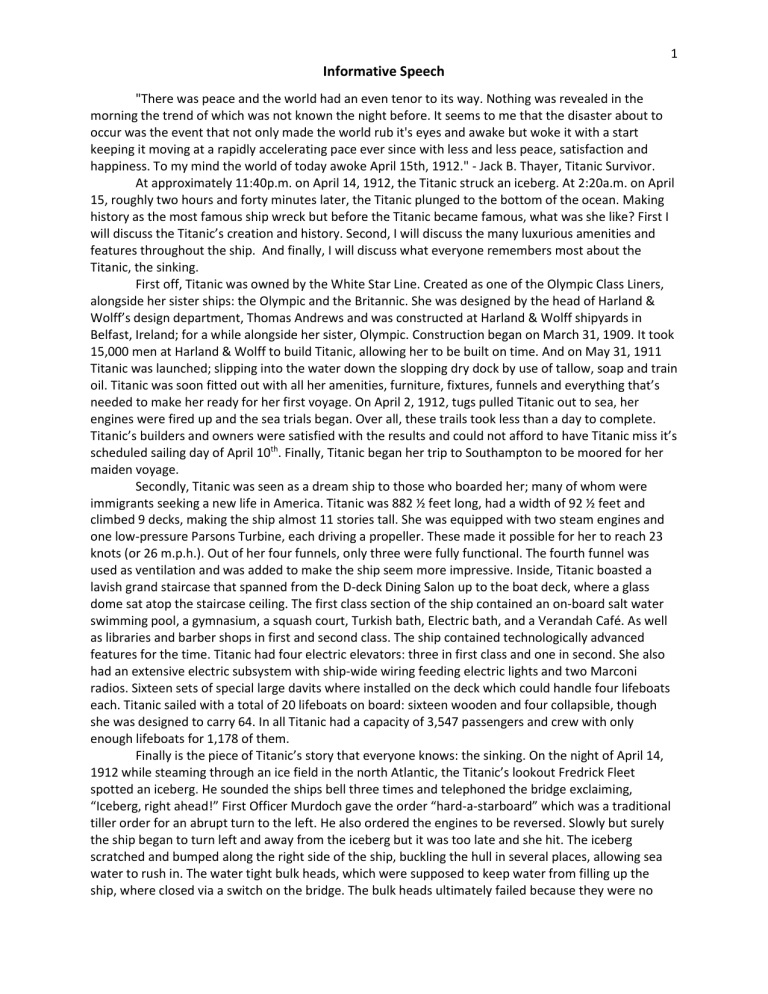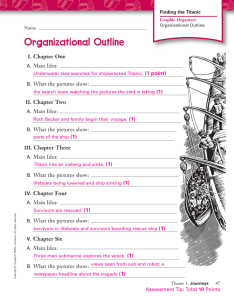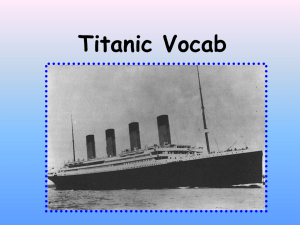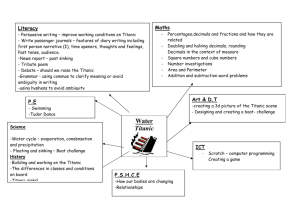
1 Informative Speech "There was peace and the world had an even tenor to its way. Nothing was revealed in the morning the trend of which was not known the night before. It seems to me that the disaster about to occur was the event that not only made the world rub it's eyes and awake but woke it with a start keeping it moving at a rapidly accelerating pace ever since with less and less peace, satisfaction and happiness. To my mind the world of today awoke April 15th, 1912." - Jack B. Thayer, Titanic Survivor. At approximately 11:40p.m. on April 14, 1912, the Titanic struck an iceberg. At 2:20a.m. on April 15, roughly two hours and forty minutes later, the Titanic plunged to the bottom of the ocean. Making history as the most famous ship wreck but before the Titanic became famous, what was she like? First I will discuss the Titanic’s creation and history. Second, I will discuss the many luxurious amenities and features throughout the ship. And finally, I will discuss what everyone remembers most about the Titanic, the sinking. First off, Titanic was owned by the White Star Line. Created as one of the Olympic Class Liners, alongside her sister ships: the Olympic and the Britannic. She was designed by the head of Harland & Wolff’s design department, Thomas Andrews and was constructed at Harland & Wolff shipyards in Belfast, Ireland; for a while alongside her sister, Olympic. Construction began on March 31, 1909. It took 15,000 men at Harland & Wolff to build Titanic, allowing her to be built on time. And on May 31, 1911 Titanic was launched; slipping into the water down the slopping dry dock by use of tallow, soap and train oil. Titanic was soon fitted out with all her amenities, furniture, fixtures, funnels and everything that’s needed to make her ready for her first voyage. On April 2, 1912, tugs pulled Titanic out to sea, her engines were fired up and the sea trials began. Over all, these trails took less than a day to complete. Titanic’s builders and owners were satisfied with the results and could not afford to have Titanic miss it’s scheduled sailing day of April 10th. Finally, Titanic began her trip to Southampton to be moored for her maiden voyage. Secondly, Titanic was seen as a dream ship to those who boarded her; many of whom were immigrants seeking a new life in America. Titanic was 882 ½ feet long, had a width of 92 ½ feet and climbed 9 decks, making the ship almost 11 stories tall. She was equipped with two steam engines and one low-pressure Parsons Turbine, each driving a propeller. These made it possible for her to reach 23 knots (or 26 m.p.h.). Out of her four funnels, only three were fully functional. The fourth funnel was used as ventilation and was added to make the ship seem more impressive. Inside, Titanic boasted a lavish grand staircase that spanned from the D-deck Dining Salon up to the boat deck, where a glass dome sat atop the staircase ceiling. The first class section of the ship contained an on-board salt water swimming pool, a gymnasium, a squash court, Turkish bath, Electric bath, and a Verandah Café. As well as libraries and barber shops in first and second class. The ship contained technologically advanced features for the time. Titanic had four electric elevators: three in first class and one in second. She also had an extensive electric subsystem with ship-wide wiring feeding electric lights and two Marconi radios. Sixteen sets of special large davits where installed on the deck which could handle four lifeboats each. Titanic sailed with a total of 20 lifeboats on board: sixteen wooden and four collapsible, though she was designed to carry 64. In all Titanic had a capacity of 3,547 passengers and crew with only enough lifeboats for 1,178 of them. Finally is the piece of Titanic’s story that everyone knows: the sinking. On the night of April 14, 1912 while steaming through an ice field in the north Atlantic, the Titanic’s lookout Fredrick Fleet spotted an iceberg. He sounded the ships bell three times and telephoned the bridge exclaiming, “Iceberg, right ahead!” First Officer Murdoch gave the order “hard-a-starboard” which was a traditional tiller order for an abrupt turn to the left. He also ordered the engines to be reversed. Slowly but surely the ship began to turn left and away from the iceberg but it was too late and she hit. The iceberg scratched and bumped along the right side of the ship, buckling the hull in several places, allowing sea water to rush in. The water tight bulk heads, which were supposed to keep water from filling up the ship, where closed via a switch on the bridge. The bulk heads ultimately failed because they were no 2 Informative Speech taller than E deck. As the water rushed in and the ship’s list grew steeper, the water began pouring over the top of the bulkheads and into the next compartment. Titanic’s Marconi operators continued to work, trying to reach any ship that was close enough to come to their rescue. The only ship to respond that was close was the Carpathia, yet she was still 58 miles away: hours from the Titanic. By morning light, the Carpathia sailed in to find no ship, but only 20 lifeboats floating in the water. Only 705 passengers and crew survived the tragedy. Titanic had taken 1,503 souls with it to the ocean floor. Looking back on the actions from that night, many mistakes can be pointed out but the most prominent of these mistakes are of that of First Officer Murdoch. He was the official who called ‘hard-astarboard’ and demanded to have the engines reversed. Had he not reversed the engines and continued sailing full speed, the ship would have turned in enough time to miss the looming iceberg. The faster a ship is going forward, the faster it can turn. As well, if the order had not been called to turn the ship and they had hit the iceberg head on, it would have caused damage to the bow of the ship but still been able to float on and be fixed later on. The Titanic, with its grandeur and beauty, was a ship of wonders, dreams and amazement for so many of its passengers. She was just a concept at one point, drawn up and built into reality. Her journey started several years before her fateful voyage across the Atlantic. The Titanic was built, fitted, was put through sea trails and finally transported to Southampton for her maiden voyage. She was seen as the largest and most luxurious ship of her time. Boast amenities, such as the grand staircase, Turkish bath, on-board swimming pool and café’s and so much more. But with an unexpected twist of fate, she struck an iceberg late one night in mid-April. Plunging the once great and majestic ship into darkness forever. "To my poor fellow-sufferers: My heart overflows with grief for you all and is laden with sorrow that you are weighed down with this terrible burden that has been thrust upon us. May God be with us and comfort us all.” – Eleanor Smith, wife of the late Captain Smith.




